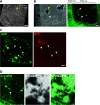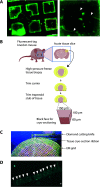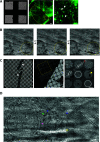Bridging length scales from molecules to the whole organism by cryoCLEM and cryoET
- PMID: 35959706
- PMCID: PMC9642002
- DOI: 10.1039/d2fd00081d
Bridging length scales from molecules to the whole organism by cryoCLEM and cryoET
Abstract
Resolving atomic structures of isolated proteins has uncovered mechanisms and fundamental processes in biology. However, many functions can only be tested in the context of intact cells and tissues that are many orders of magnitude larger than the macromolecules on which they depend. Therefore, methods that interrogate macromolecular structure in situ provide a means of directly relating structure to function across length scales. Here, we developed several workflows using cryogenic correlated light and electron microscopy (cryoCLEM) and electron tomography (cryoET) that can bridge this gap to reveal the molecular infrastructure that underlies higher order functions within cells and tissues. We also describe experimental design considerations, including cryoCLEM labelling, sample preparation, and quality control, for determining the in situ molecular architectures within native, hydrated cells and tissues.
Conflict of interest statement
There are no conflicts of interest to declare.
Figures




Similar articles
-
Correlative cryo-microscopy pipelines for in situ cellular studies.Methods Cell Biol. 2024;187:175-203. doi: 10.1016/bs.mcb.2024.02.038. Epub 2024 Mar 27. Methods Cell Biol. 2024. PMID: 38705624
-
Charting the molecular landscape of the cell.Structure. 2023 Nov 2;31(11):1297-1305. doi: 10.1016/j.str.2023.08.015. Epub 2023 Sep 11. Structure. 2023. PMID: 37699393 Free PMC article. Review.
-
Precise targeting for 3D cryo-correlative light and electron microscopy volume imaging of tissues using a FinderTOP.Commun Biol. 2023 May 11;6(1):510. doi: 10.1038/s42003-023-04887-y. Commun Biol. 2023. PMID: 37169904 Free PMC article.
-
Electron cryo-tomography captures macromolecular complexes in native environments.Curr Opin Struct Biol. 2017 Oct;46:149-156. doi: 10.1016/j.sbi.2017.08.005. Epub 2017 Sep 13. Curr Opin Struct Biol. 2017. PMID: 28915442 Review.
-
In Situ Cryo-Electron Tomography: A Post-Reductionist Approach to Structural Biology.J Mol Biol. 2016 Jan 29;428(2 Pt A):332-343. doi: 10.1016/j.jmb.2015.09.030. Epub 2015 Oct 9. J Mol Biol. 2016. PMID: 26456135 Review.
Cited by
-
Learning structural heterogeneity from cryo-electron sub-tomograms with tomoDRGN.Nat Methods. 2024 Aug;21(8):1525-1536. doi: 10.1038/s41592-024-02210-z. Epub 2024 Mar 8. Nat Methods. 2024. PMID: 38459385 Free PMC article.
-
Memory engram synapse 3D molecular architecture visualized by cryoCLEM-guided cryoET.bioRxiv [Preprint]. 2025 Jan 12:2025.01.09.632151. doi: 10.1101/2025.01.09.632151. bioRxiv. 2025. PMID: 39829918 Free PMC article. Preprint.
-
Learning structural heterogeneity from cryo-electron sub-tomograms with tomoDRGN.bioRxiv [Preprint]. 2023 Jun 2:2023.05.31.542975. doi: 10.1101/2023.05.31.542975. bioRxiv. 2023. Update in: Nat Methods. 2024 Aug;21(8):1525-1536. doi: 10.1038/s41592-024-02210-z. PMID: 37398315 Free PMC article. Updated. Preprint.
References
Publication types
MeSH terms
Substances
Grants and funding
LinkOut - more resources
Full Text Sources
Miscellaneous

